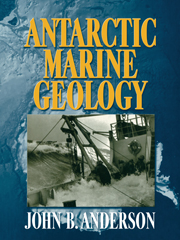Book contents
CHAPTER 5 - Continental Margin Evolution
Published online by Cambridge University Press: 06 December 2010
Summary
Knowledge of the geology of the Antarctic continental margin draws on extrapolations of marine and aerial geophysical surveys, the few drill sites in the region, the geology of neighboring Gondwana continents, and information gained from land-based geologic studies. The amount of information dramatically varies for different regions because of the differences in the number, quality, and types of surveys conducted. These combined conditions make the Antarctic continental shelf a formidable challenge to geologists and geophysicists attempting to unravel its geologic history.
This chapter presents results of marine geologic and geophysical surveys conducted to date on the Antarctic continental margin. The objective is to describe the tectonic and stratigraphic evolution of those parts of the margin that have been studied (Fig. 5.1). The continental margins of East Antarctica are all passive margins resulting from the separation of Africa, India, and Australia from Antarctica. The West Antarctic continental margin has had a more complex evolution and remains the more poorly understood of the two margins. Discussion will first focus on the West Antarctic continental margin, starting with the Ross Sea and followed by the Pacific-Antarctic Margin and western Weddell Sea. Discussions of the East Antarctic continental margins include the Queen Maud Land, Wilkes Land, and Prydz Bay margins. Each region is discussed separately, and each section includes a description of the tectonic history and stratigraphy.
ROSS SEA
The Ross Sea forms a large embayment on the Antarctic coast at the boundary between East and West Antarctica. It is bounded on the west by the TAM of Victoria Land, on the south by the Ross Ice Shelf, on the east by Marie Byrd Land, and on the north by the Pacific Ocean (Fig. 5.1).
- Type
- Chapter
- Information
- Antarctic Marine Geology , pp. 155 - 206Publisher: Cambridge University PressPrint publication year: 1999



